History > MARK SCHEMES > GCE History A Y309/01: The ascendency of the Ottoman Empire 1453-1606 Advanced GCE Mark Scheme for N (All)
GCE History A Y309/01: The ascendency of the Ottoman Empire 1453-1606 Advanced GCE Mark Scheme for November 2020
Document Content and Description Below
GCE History A Y309/01: The ascendency of the Ottoman Empire 1453-1606 Advanced GCE Mark Scheme for November 2020 Oxford Cambridge and RSA Examinations GCE History A Y309/01: The ascendency of th... e Ottoman Empire 1453-1606 Advanced GCE Mark Scheme for November 2020Oxford Cambridge and RSA Examinations OCR (Oxford Cambridge and RSA) is a leading UK awarding body, providing a wide range of qualifications to meet the needs of candidates of all ages and abilities. OCR qualifications include AS/A Levels, Diplomas, GCSEs, Cambridge Nationals, Cambridge Technicals, Functional Skills, Key Skills, Entry Level qualifications, NVQs and vocational qualifications in areas such as IT, business, languages, teaching/training, administration and secretarial skills. It is also responsible for developing new specifications to meet national requirements and the needs of students and teachers. OCR is a not-for-profit organisation; any surplus made is invested back into the establishment to help towards the development of qualifications and support, which keep pace with the changing needs of today’s society. This mark scheme is published as an aid to teachers and students, to indicate the requirements of the examination. It shows the basis on which marks were awarded by examiners. It does not indicate the details of the discussions which took place at an examiners’ meeting before marking commenced. All examiners are instructed that alternative correct answers and unexpected approaches in candidates’ scripts must be given marks that fairly reflect the relevant knowledge and skills demonstrated. Mark schemes should be read in conjunction with the published question papers and the report on the examination. © OCR 2020Y309/01 Mark Scheme November 2020 2 Annotations Annotation Meaning of annotation Blank Page Highlight Off-page comment Assertion Analysis Evaluation Explanation Factor Illustrates/Describes Irrelevant, a significant amount of material that does not answer the question Judgement Knowledge and understanding Provenance Simple comment Unclear View Synthesis Continuity/ChangeY309/01 Mark Scheme November 2020 3 Subject Specific Marking Instructions Section A Question Answer/Indicative content Mark Guidance 1 Evaluate the interpretations in both of the two passages and explain which you think is more convincing as an explanation of the significance of the battle of Lepanto (1571) for the ascendancy of the Ottoman Empire. • In locating the Interpretations within the wider historical debate, answer might argue that Interpretation A puts forward the view that the Holy League was unable to inflict a significant defeat and Lepanto was soon avenged, therefore having little overall significance for the Ottoman ascendancy. • In evaluating Interpretation A, answers might argue that this view is valid as the Holy League’s aim of retaking Cyprus failed. • Answers might argue that Interpretation A is valid as only 30 Ottoman galleys escaped and so it was a spectacular event. • Answers might argue Interpretation A is valid as the Holy League could not follow up its victory because of the loss of men and bad weather. • Answers might argue Interpretation A is valid because by 1606 there were no major signs of military decline. • Answers might argue that Interpretation A is not valid as the dynamic of expansion was over. • In locating the Interpretations within the wider historical debate, answers might argue that 30 • No set answer is expected • At Level 5 and above answers will evaluate both interpretations, locating them within the wider historical debate about the issue and using their own knowledge, and reach a balanced judgement as to which they consider the most convincing about the issue in the question. • To be valid, judgements must be supported by relevant and accurate material. • Knowledge must not be credited in isolation, it should only be credited where it is used to analyse and evaluate the interpretations, in line with descriptions in the levels mark schemeY309/01 Mark Scheme November 2020 4 2* Interpretation B puts forward the view that the status quo was retained but the Ottomans were exhausted and had reached the limits of their expansion. • In evaluating Interpretation B, answers might argue it is valid as the Ottomans were unable to make significant gains after this. • Answers might argue that Interpretation B is valid as the Venetians did give up Cyprus, paid a war indemnity and reduced the size of its fleet. • Answers might consider that trading agreements were important as Venice needed grain and they were heavily involved in the carrying trade. • Answers might argue that Interpretation B is valid as the Holy League collapsed and this allowed Ottoman dominance in the East to continue. • Answers might argue that Interpretation B is not valid as in 1572 they had been able to rebuild their fleet and drive the Holy League out of the Eastern Mediterranean. • Answers might argue that Interpretation B is not valid as there was no real sign of Ottoman decline by 1606. • Answers might consider that Interpretation B is not valid as Lepanto was only a short-term defeat as they were able to defeat the Spanish garrison at Tunis in 3 years. ‘Throughout the period from 1453 to 1606 Ottoman Sultans were able to maintain their absolute power.’ How far do you agree? 25 • No set answer is expectedY309/01 Mark Scheme November 2020 5 • In arguing that the Ottoman Sultans maintained absolute power, it might be argued that the janissaries owed obedience to the Sultan. • Answers might consider that the capture of Constantinople gave the Sultan the right to the title khan rather than just ghazi. • Answers might consider that fratricide maintained the single line of succession. • Answers might consider that all the land belonged to the Sultan. • Answers might consider that in theory he had absolute power over slaves, Muslim and nonMuslim subjects • Answers might consider that the Sultan could make laws. • Answers might consider that he was commander in chief and made all government appointments; he was also Imam. • In arguing that they did not maintain absolute power, it might be argued that their laws could not contravene religious laws. • Answers might consider that his power depended upon his personality and character. • Answers might consider the extent to which the size of the Empire limited his power. • Answers might consider the factional fighting at court after the death of Suleiman. • Answers might consider that the system was based on conquest and when that ended it created problems. • Answers might consider the weaknesses of Selim II, Murad III or Mehmed III. • Answers might consider the rebellions against the Sultan, particularly the Janissaries in 1589. • At higher levels answers might establish criteria against which to judge • To be valid, judgements must be supported by relevant and accurate material. • Knowledge must not be credited in isolation, it should only be credited where it is used as the basis for analysis and evaluation, in line with descriptions in the levels mark scheme.Y309/01 Mark Scheme November 2020 6 3* To what extent did Ottoman conquests bring about a loss of freedom for the peoples of the vassal states in the period from 1453 to 1606? In supporting the hypothesis that the peoples of the vassal states lost their freedom, it might be argued that toleration was unusual in Europe at this time. • Answers might consider that sons were taken to serve in the army and became slaves (Devshirme). • Answers might consider that the conquered lands had to pay tribute and taxes. • Answers might consider that Janissaries were not able to marry, so as to remain loyal only to the Sultan. • Answers might consider that the less able became Janissaries and as part of their training had to work as agricultural labourers. • Answers might consider that the Timar system of land tenure was harsh. • In challenging the hypothesis and arguing that the people of the vassal states did not lose their freedom, it might be argued that offices were open to anyone; anyone could become Grand Vizier. • Answers might consider that living conditions for the Devshirme were better than those in a Balkan village. • Answers might consider that people could rise in status and wealth. • Answers might consider that religious toleration was allowed. • Answers might consider that the peoples gained peace and stability which improved their day to day freedoms in many areas. 25 • No set answer is expected • At higher levels answers might establish criteria against which to judge • To be valid, judgements must be supported by relevant and accurate material. • Knowledge must not be credited in isolation, it should only be credited where it is used as the basis for analysis and evaluation, in line with descriptions in the levels mark scheme.Y309/01 Mark Scheme November 2020 7 4* ‘The Ottoman threat to Spain and its North African outposts was never serious.’ How far do you agree with this view of the period from 1453 to 1606? • In supporting the hypothesis that the threat was never serious, it might be argued that they were not powerful enough and could not maintain supply lines in the Western Mediterranean. • Answers might consider that they were more concerned with expansion into Asia. • Answers might consider that they were only a threat because of the Habsburg Valois division and that ended after 1559. • Answers might consider that in the early period and after Lepanto their dominance was limited to the Eastern Mediterranean. • Answers might consider that Charles V was able to remove the Turks from Tunis – although only in the short term. • Answers might consider that the Turks were unable to take Malta which would have given them dominance of the Mediterranean. • In challenging the hypothesis in the question, it might be argued that they threatened Spain because of their alliance with France. • Answers might consider that fall of Tunis, 1534, showed the threat. • Answers might consider that there was potential for support from Muslims within Spain. • Answers might consider that they made use of the Barbary pirates and its leader Barbarossa. • Answers might consider the naval victory against Spain, Venice and the Papacy in 1538. 25 • No set answer is expected • At higher levels answers might establish criteria against which to judge • To be valid, judgements must be supported by relevant and accurate material. • Knowledge must not be credited in isolation, it should only be credited where it is used as the basis for analysis and evaluation, in line with descriptions in the levels mark scheme.Y309/01 Mark Scheme November 2020 8 • Answers might consider that the Ottoman fleet wintered at Toulon in 1540-1. • Answers might consider the defeat off Djerba in 1560. • Answers might consider the ‘alliance’ made with the Barbary pirates. • Answers might consider the fall of Rhodes.Y309/01 Mark Scheme November 2020 9 APPENDIX 2 – this section contains additional subject specific information Use this space if you have extensive subject specific information that is inappropriate to include elsewhere.OCR (Oxford Cambridge and RSA Examinations) The Triangle Building Shaftesbury Road Cambridge CB2 8EA [Show More]
Last updated: 2 years ago
Preview 1 out of 11 pages
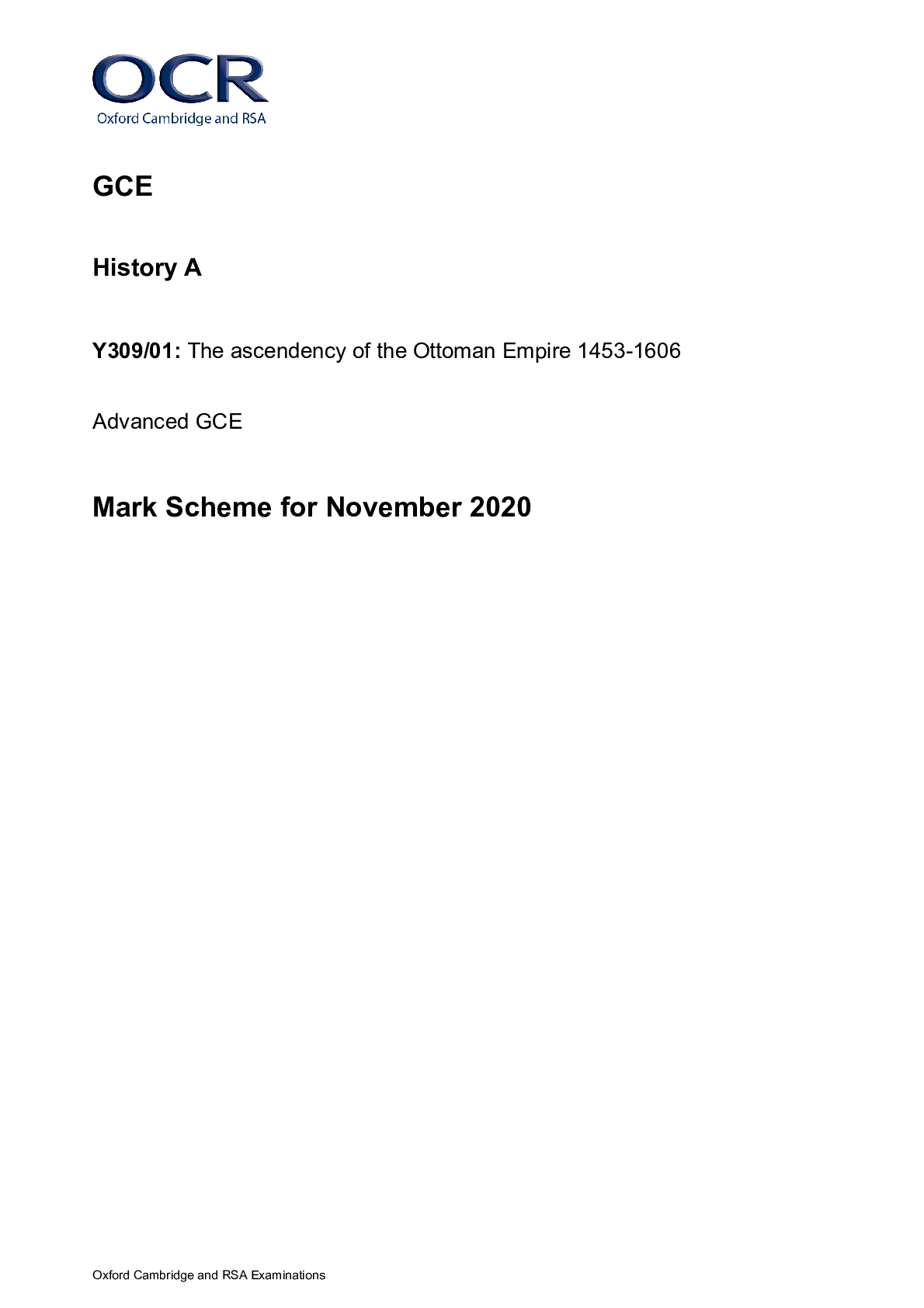
Buy this document to get the full access instantly
Instant Download Access after purchase
Buy NowInstant download
We Accept:

Reviews( 0 )
$6.50
Can't find what you want? Try our AI powered Search
Document information
Connected school, study & course
About the document
Uploaded On
Jul 17, 2022
Number of pages
11
Written in
Additional information
This document has been written for:
Uploaded
Jul 17, 2022
Downloads
0
Views
68





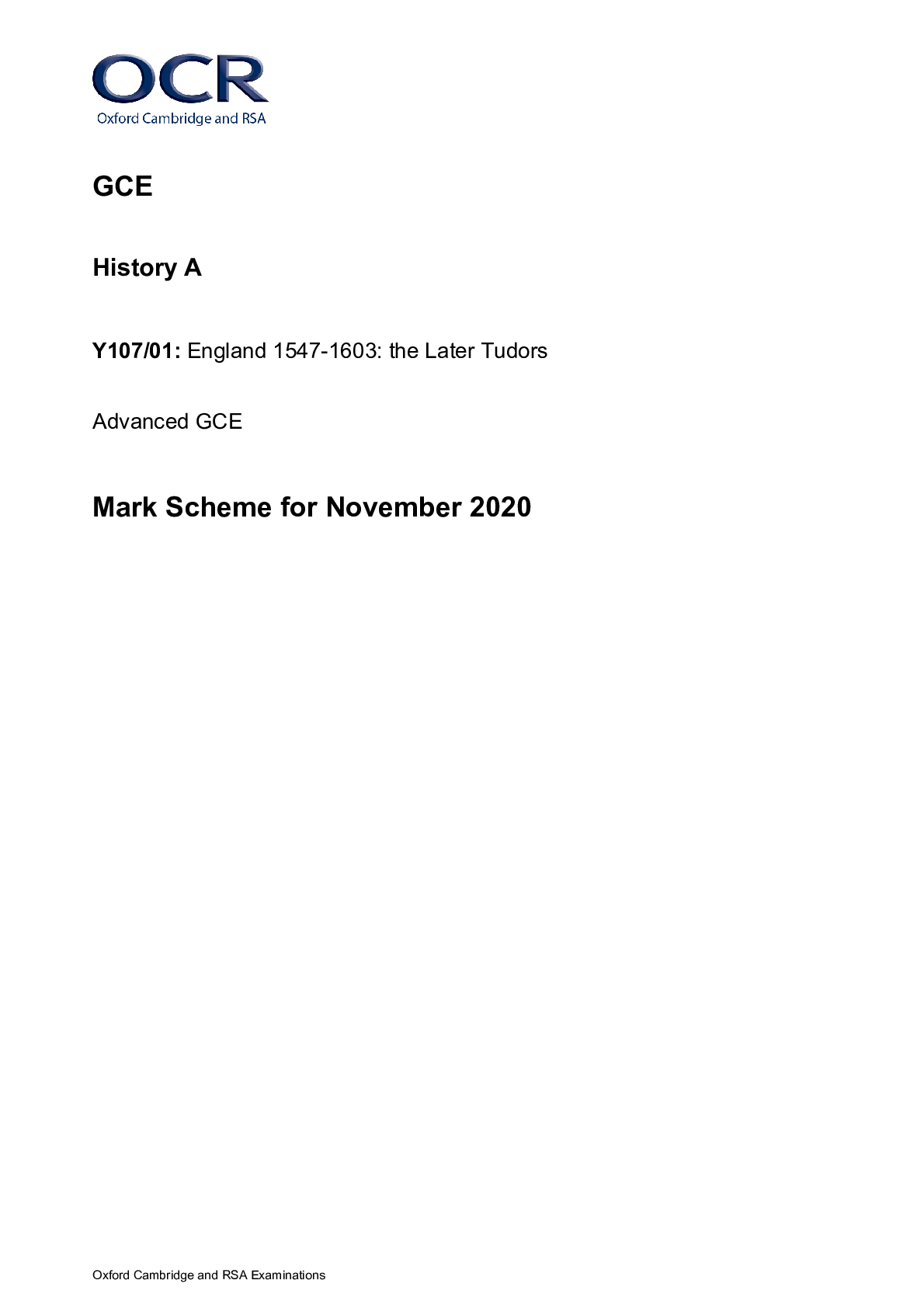
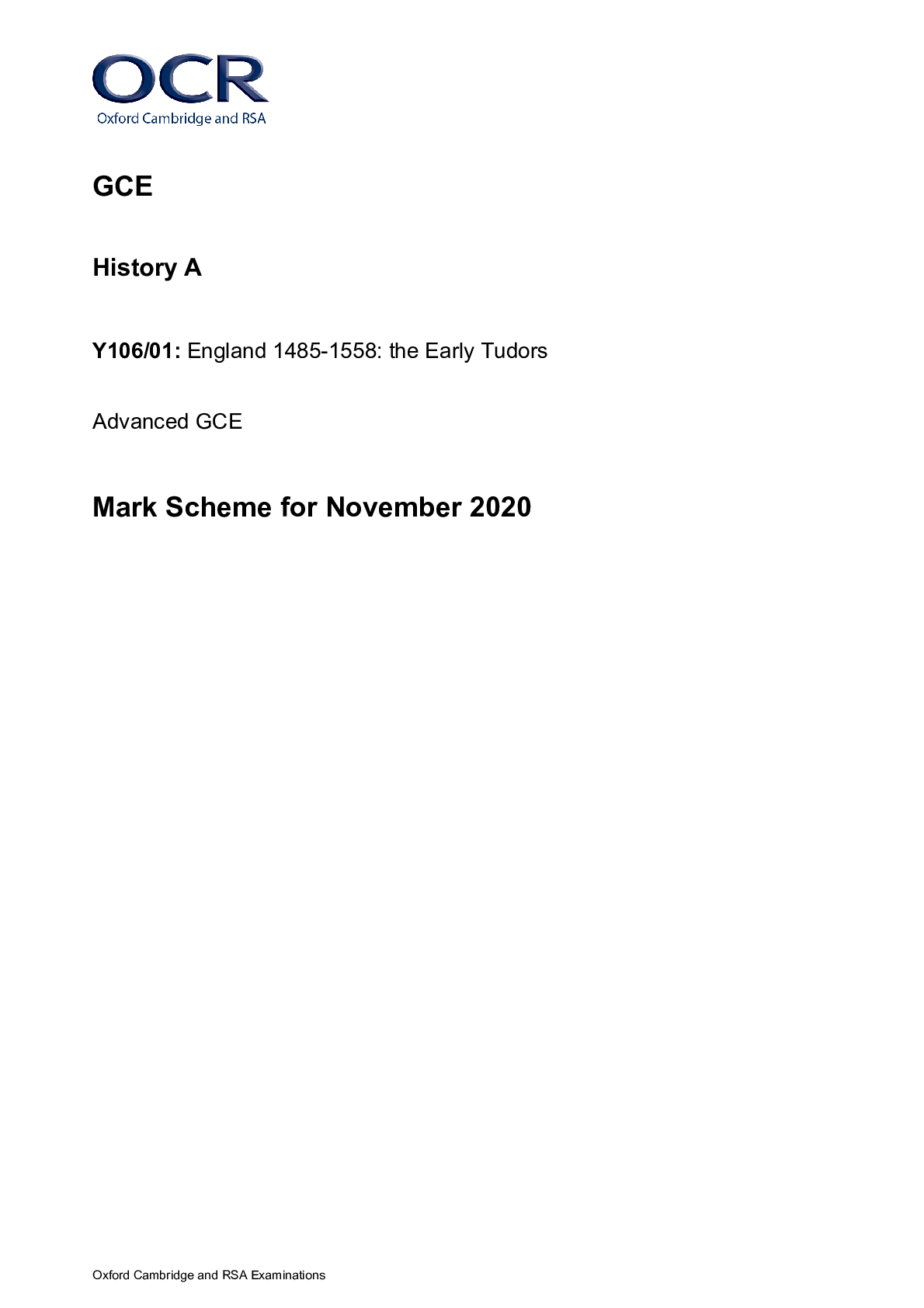
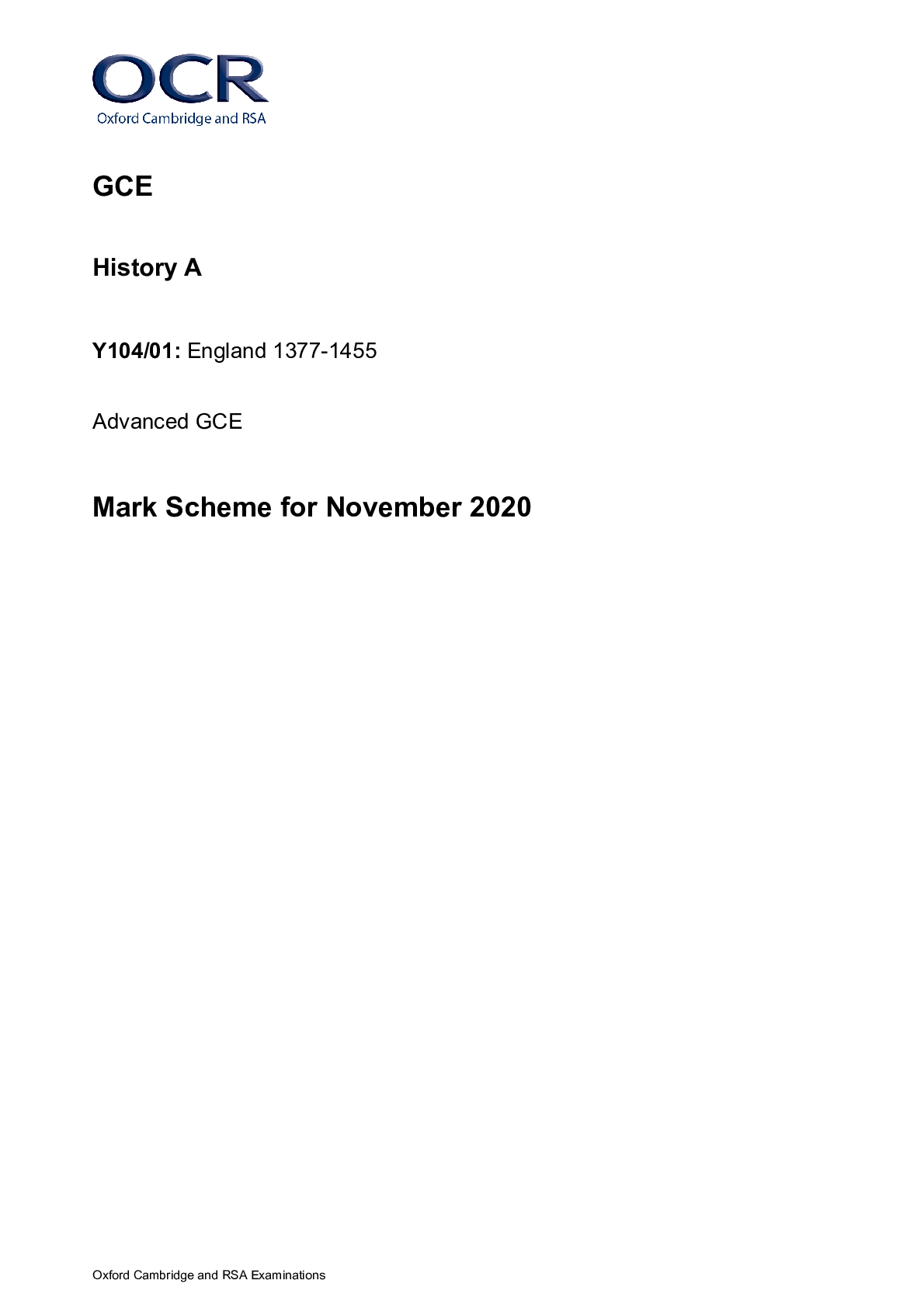
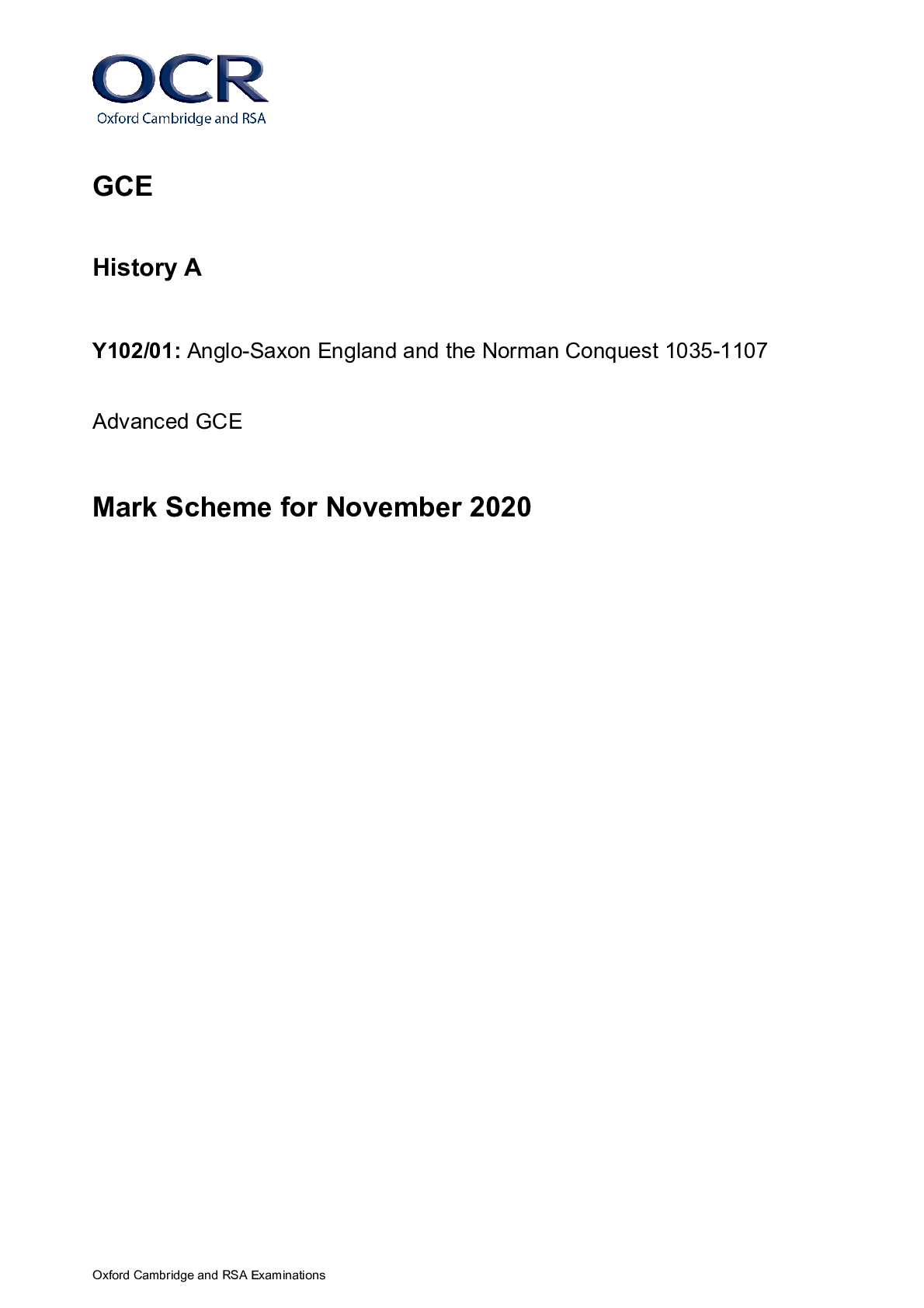
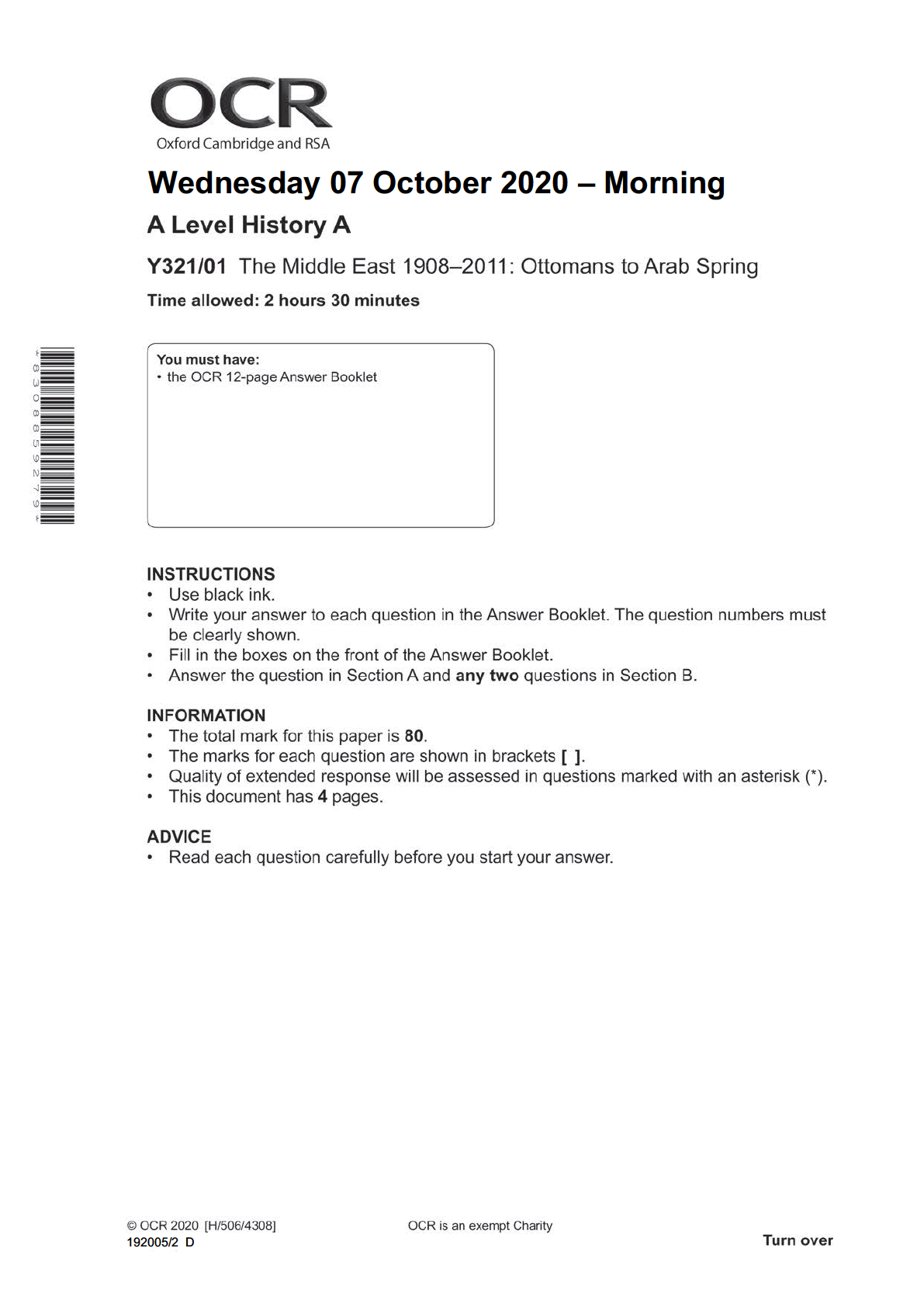
.png)

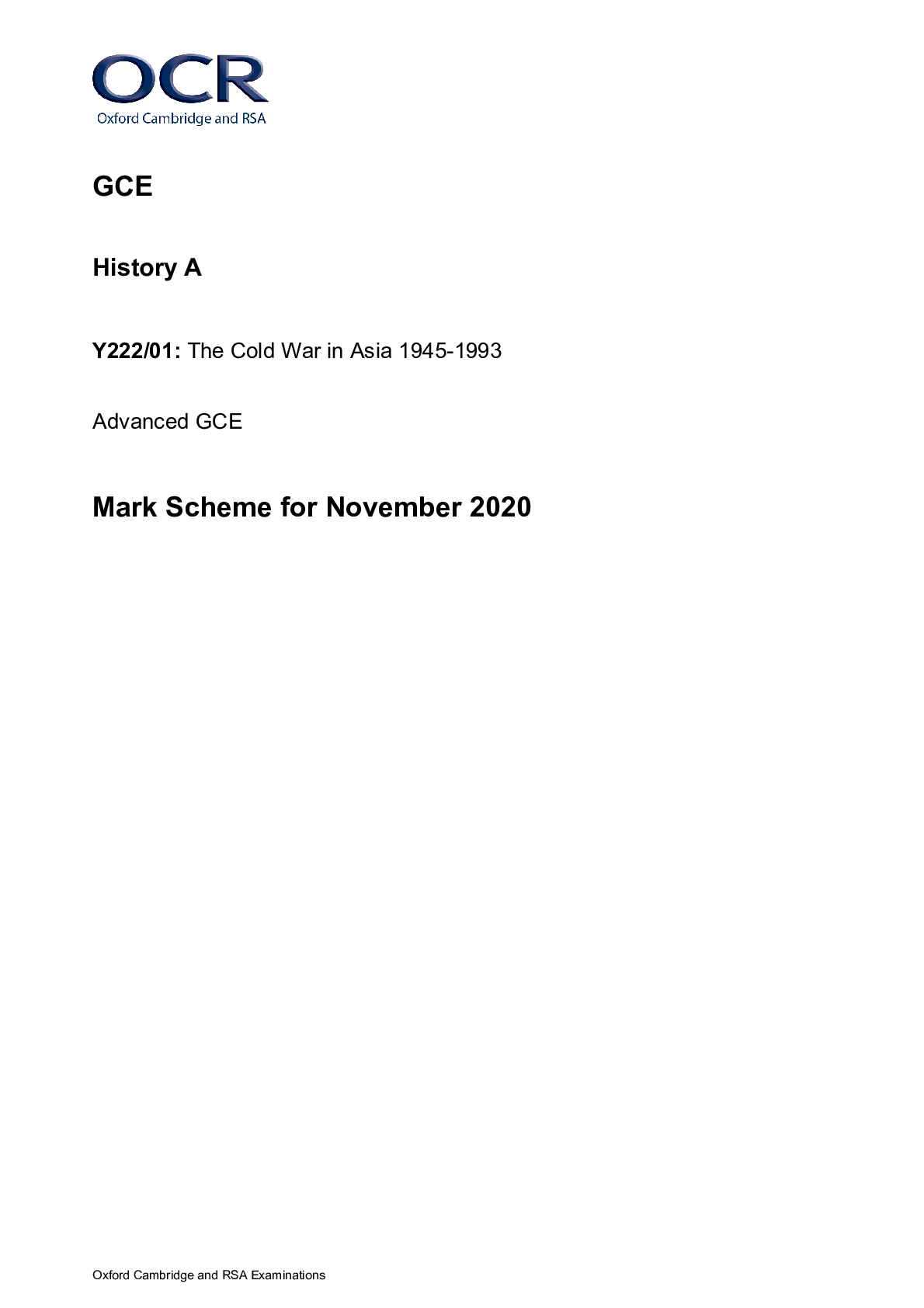



.png)









